We had tried to book an early train to Hiroshima, but all seats were taken, the best we could do was get one just after midday, which meant arriving on the island in late afternoon.
So with breakfast at eight, then a shower, pack and the usual stuff. We had already sent the big cases on ahead, so we just have the camera gear and the overnight bag. we get a taxi to take us to the station at half ten, so I could take some shots of trains and stuff, and for us to buy a bento for lunch each, which we would eat on the 2nd train of the trip.
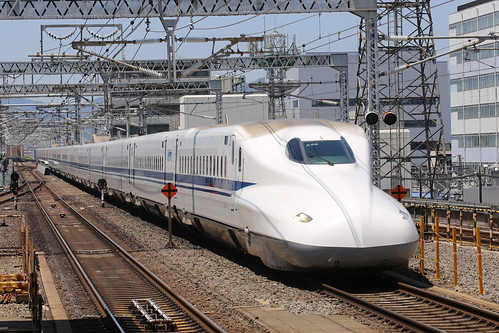 I take many shots, but the excitement of seeing the bullet trains was beginning to wear off, but I rattle off 50 shots or so before going to the store to buy one of the bento meals. Rice, tempura, vegetables, pickles, all in a nice box with chopsticks. Eating like locals now.
I take many shots, but the excitement of seeing the bullet trains was beginning to wear off, but I rattle off 50 shots or so before going to the store to buy one of the bento meals. Rice, tempura, vegetables, pickles, all in a nice box with chopsticks. Eating like locals now.We take the first train for the half hour ride to Shin-Osaka, then wait for 20 minutes for our connection to Hiroshima. We crowd on, and despite worrying that there would be no seats for us, there they were. We arrive in Osaka, and have another half hour to wait; so, I wander around taking yet more shots of bullet trains until it was time for ours to come in. In fact, ours came in as I was at the far end of the platform, and this one was made up of just ten or so coaches, so I had to double back down to Jools and Jen before we climbed on board. We needn't have worried as our seats were there, all empty.
And once in our seat we could munch away, eating the bento as Japan slid past outside our window. Perfect way to spend the afternoon.
The landscape changed; instead of paddy fields, there were large hills, all covered in what looked like thick rainforest. And this continued for two hours until we arrived.
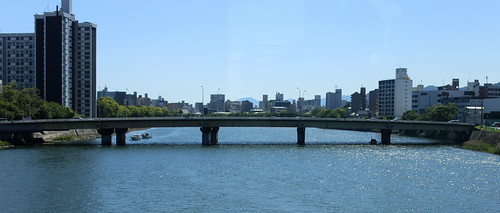 Once at Hiroshima, we have to make our way to the JR lines platforms, and get a train to the port for the ferry. After asking people on the train, we find the right train and work out we have seven stops or something. The train crosses three rivers, then winds its way through quiet neighbourhoods and as we get nearer the sea and the port, racing a tram a hundred yards away that is also making its way to the port.
Once at Hiroshima, we have to make our way to the JR lines platforms, and get a train to the port for the ferry. After asking people on the train, we find the right train and work out we have seven stops or something. The train crosses three rivers, then winds its way through quiet neighbourhoods and as we get nearer the sea and the port, racing a tram a hundred yards away that is also making its way to the port.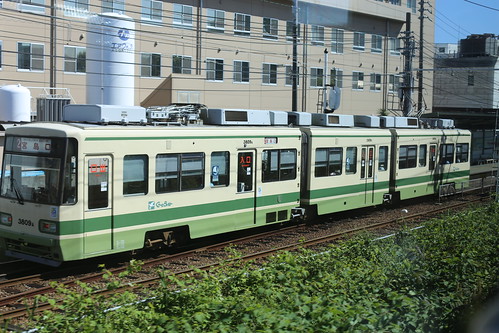 There are clear signs, pointing the way to the ferry, down a street, down and up an underpass, cross another street then into the port building, and as the ferry was owned by JR, we flash our passes and get let onto the gangplank, waiting for the ferry to dock. Which is does in about 5 minutes.
There are clear signs, pointing the way to the ferry, down a street, down and up an underpass, cross another street then into the port building, and as the ferry was owned by JR, we flash our passes and get let onto the gangplank, waiting for the ferry to dock. Which is does in about 5 minutes.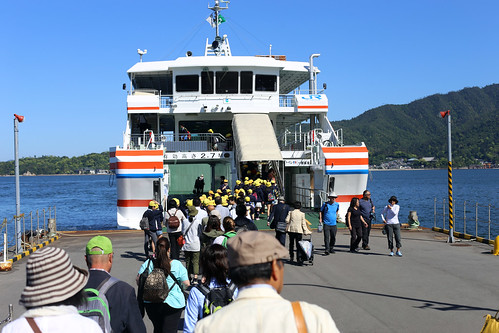 It is a perfect summer afternoon, hot with clear blue skies and a gentle breeze, so we take seats on the outside of the ferry for the ten minute crossing to Miyajima. The ferry is full of schoolchildren, all dressed in what seems like naval uniforms, but is just the style for that school. And once disembarked, they like up with several other classes, dressed in slightly different uniforms before being marched to the temple.
It is a perfect summer afternoon, hot with clear blue skies and a gentle breeze, so we take seats on the outside of the ferry for the ten minute crossing to Miyajima. The ferry is full of schoolchildren, all dressed in what seems like naval uniforms, but is just the style for that school. And once disembarked, they like up with several other classes, dressed in slightly different uniforms before being marched to the temple.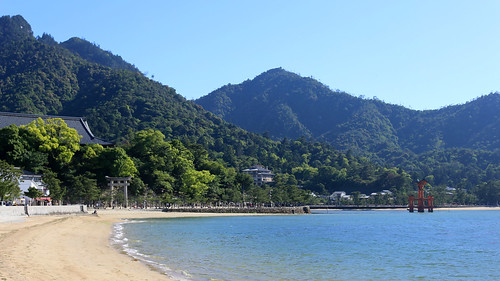 Miyajima is famous in Japan for having a shrine, the Floating Gate, and a Buddhist temple complex near the gate. It also has a herd of friendly deer. This I know now, as one ate a shopping bag as we walked on the path beside the sea to our accommodation.
Miyajima is famous in Japan for having a shrine, the Floating Gate, and a Buddhist temple complex near the gate. It also has a herd of friendly deer. This I know now, as one ate a shopping bag as we walked on the path beside the sea to our accommodation.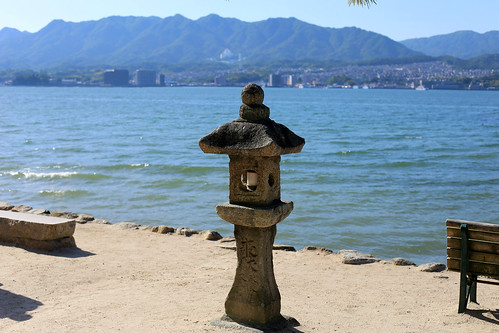 It was hot, I mean really oppressively hot.
It was hot, I mean really oppressively hot.I say accommodation rather than hotel, because to get the full on Japanese flavour, we were booked two nights at a ryokan, or traditional B&B, that really has nothing to do with what you might get in an British one.
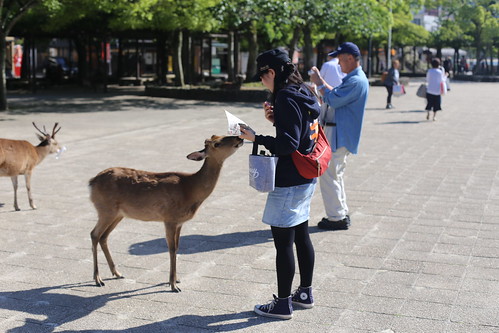 We could have gotten a free shuttle bus, but we thought we would walk, as it was such a nice day. A small army of schoolchildren got off the ferry with us, for a tour of the temple complex, making it seem very busy indeed. We stop for an ice cream in the shade of some trees, and a couple of deer join us to see if we might feed them. One takes another bite out of the shopping bag, and is not best pleased when we take it away from him.
We could have gotten a free shuttle bus, but we thought we would walk, as it was such a nice day. A small army of schoolchildren got off the ferry with us, for a tour of the temple complex, making it seem very busy indeed. We stop for an ice cream in the shade of some trees, and a couple of deer join us to see if we might feed them. One takes another bite out of the shopping bag, and is not best pleased when we take it away from him.We walk past the gate, past the temple and the collection of shops and restaurants to where we were assured there would be signs for the ryokan. We find a sign, then another pointing back in the direction we had just come from. A woman in a tat shop didn't help either.
We ask the owner of a shop, and she points us back along the way we had come. Wefind the lobby of a hotel, but it is the wrong one, and they tell us to continue as we had before.
Further up the track towards the cable car we came to the ryokan.
This is a very famous place in Japan, meant nothing to us of course. But various Emperors have stayed here. The staff bowed to us, and made us welcome. We were taken to our our room, which seemed very bare. This is what you think of as a traditional Japanese house, all rice paper walls, sliding doors, and chairs with no legs.
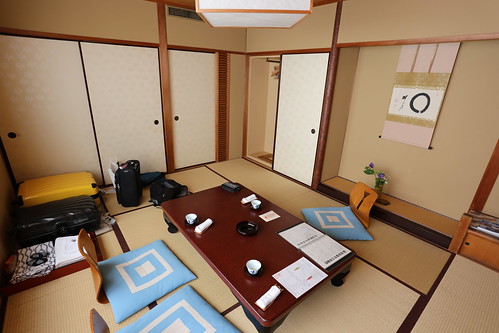 Our personal assistant came up, poured us green tea and explained what would happen. We put on traditional clothes, were told that when we had dinner, our futon would be made up. We were shown the two shelves that amounted to our space for storage, we had three suitcases on the floor, overflowing with stuff. It seemed we had already ruined the simplicity of the ryokan.
Our personal assistant came up, poured us green tea and explained what would happen. We put on traditional clothes, were told that when we had dinner, our futon would be made up. We were shown the two shelves that amounted to our space for storage, we had three suitcases on the floor, overflowing with stuff. It seemed we had already ruined the simplicity of the ryokan.We go for a walk in the afternoon, already the town was emptying as people left for the day on the last of the ferries. With the sun quickly setting in the west, my plan was to snap the sunset behind the floating gate. Sadly, it was low tide which ruined the effect and also meant that people were walking on the sand around it, some followed by hungry deer too.
Jen and Jools went on a tonic water shopping expedition, whilst I waited for the sun to set with the gate in the foreground. The effect took an hour to take effect, but was worth it, just watching the colours change and darkness begin to fall.
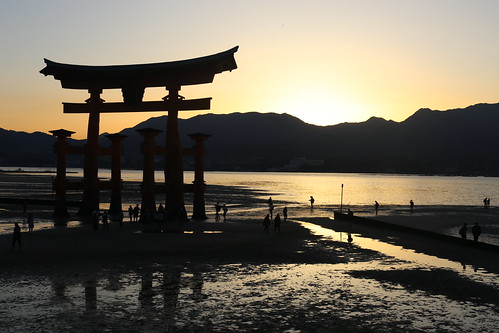 We had to be back at the ryokan for half seven for our dinner, a 12 course feast made from dozens of bowls of food, some fresh, some cooked and some pickled. It was a bit of a gamble as to what the next mouthful might be, we were given a menu so had an idea. It was rather wonderful really, and all served by Aki dressed in traditional costume, bowing and serving whilst kneeling.
We had to be back at the ryokan for half seven for our dinner, a 12 course feast made from dozens of bowls of food, some fresh, some cooked and some pickled. It was a bit of a gamble as to what the next mouthful might be, we were given a menu so had an idea. It was rather wonderful really, and all served by Aki dressed in traditional costume, bowing and serving whilst kneeling.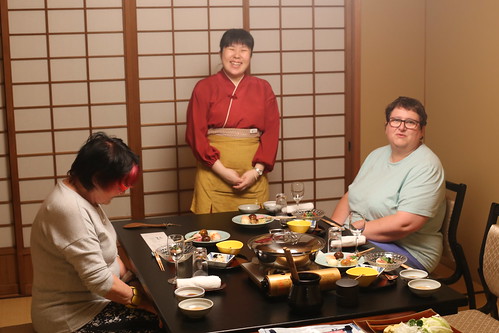 The menu from the Ryokan Iwaso:
The menu from the Ryokan Iwaso:Liquor of Lemon Shintama Daigo-yose (jelly of milk and onion. Japanese ivory shell, pearly vinegar and dill herb.)
Sahimi of Setouchi (fish wrapped in Fukusa with snapdragons and Chimaki-fu gluten).
Grilled conga eel and Mozerella with Sansho Japanese pepper and Zingiber mioga.
Steamed dish: steamed Wagyu beef with seasme sauce
Deep fried shrimp dumplings and Yuba tofu skin and asparagus with spring onion and broth "tri-dashi".
Simmered dish: simmered round eggplant and abalone crab meat, okra, young corn and Kinome-an leaf bug sauce.
Rice with summer vegetables
red miso soup
pickled vegetables
Jelly of Setoda lemon, sabqyon of honey mousse of macha (green tea) and red bean.
That night Jools and I sat by the open window of our room listening to the birds singing in the dark, but clearly this had another effect; mosquitoes. And I would suffer for that in the next few days.
We play cards, drink beer and look at our alien surroundings. Our beds had been made, and so it was time for us to struggle into bed, and try to get some sleep whilst laying on the thin mattresses.
We fell asleep to the sound of insects chirping away. We really are on an island in the bay of Hiroshima.

No comments:
Post a Comment